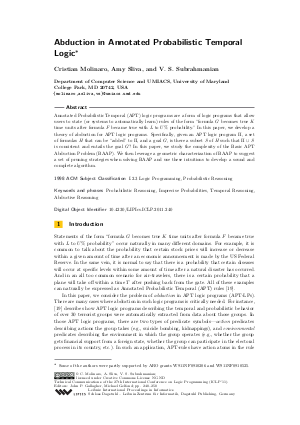Abduction in Annotated Probabilistic Temporal Logic
Authors Cristian Molinaro, Amy Sliva, V. S. Subrahmanian
-
Part of:
Volume:
Technical Communications of the 27th International Conference on Logic Programming (ICLP'11) (ICLP 2011)
Part of: Series: Leibniz International Proceedings in Informatics (LIPIcs)
Part of: Conference: International Conference on Logic Programming (ICLP) - License:
 Creative Commons Attribution-NonCommercial-NoDerivs 3.0 Unported license
Creative Commons Attribution-NonCommercial-NoDerivs 3.0 Unported license
- Publication Date: 2011-06-27
File

PDF
LIPIcs.ICLP.2011.240.pdf
- Filesize: 0.53 MB
- 11 pages
Document Identifiers
Subject Classification
Keywords
- Probabilistic Reasoning
- Imprecise Probabilities
- Temporal Reasoning
- Abductive Reasoning
Metrics
- Access Statistics
-
Total Accesses (updated on a weekly basis)
0PDF Downloads0Metadata Views
Abstract
Annotated Probabilistic Temporal (APT) logic programs are a form of logic programs that allow users to state (or systems to automatically learn)rules of the form ``formula G becomes true K time units after formula F became true with L to U% probability.'' In this paper, we develop a theory of abduction for APT logic programs. Specifically, given an APT logic program Pi, a set of formulas H that can be ``added'' to Pi, and a goal G, is there a subset S of H such that Pi \cup S is consistent and entails the goal G? In this paper, we study the complexity of the Basic APT Abduction Problem (BAAP). We then leverage a geometric characterization of BAAP to suggest a set of pruning strategies when solving BAAP and use these intuitions to develop a sound and complete algorithm.
Cite As Get BibTex
Cristian Molinaro, Amy Sliva, and V. S. Subrahmanian. Abduction in Annotated Probabilistic Temporal Logic. In Technical Communications of the 27th International Conference on Logic Programming (ICLP'11). Leibniz International Proceedings in Informatics (LIPIcs), Volume 11, pp. 240-250, Schloss Dagstuhl – Leibniz-Zentrum für Informatik (2011)
https://doi.org/10.4230/LIPIcs.ICLP.2011.240
BibTex
@InProceedings{molinaro_et_al:LIPIcs.ICLP.2011.240,
author = {Molinaro, Cristian and Sliva, Amy and Subrahmanian, V. S.},
title = {{Abduction in Annotated Probabilistic Temporal Logic}},
booktitle = {Technical Communications of the 27th International Conference on Logic Programming (ICLP'11)},
pages = {240--250},
series = {Leibniz International Proceedings in Informatics (LIPIcs)},
ISBN = {978-3-939897-31-6},
ISSN = {1868-8969},
year = {2011},
volume = {11},
editor = {Gallagher, John P. and Gelfond, Michael},
publisher = {Schloss Dagstuhl -- Leibniz-Zentrum f{\"u}r Informatik},
address = {Dagstuhl, Germany},
URL = {https://drops.dagstuhl.de/entities/document/10.4230/LIPIcs.ICLP.2011.240},
URN = {urn:nbn:de:0030-drops-31697},
doi = {10.4230/LIPIcs.ICLP.2011.240},
annote = {Keywords: Probabilistic Reasoning, Imprecise Probabilities, Temporal Reasoning, Abductive Reasoning}
}
